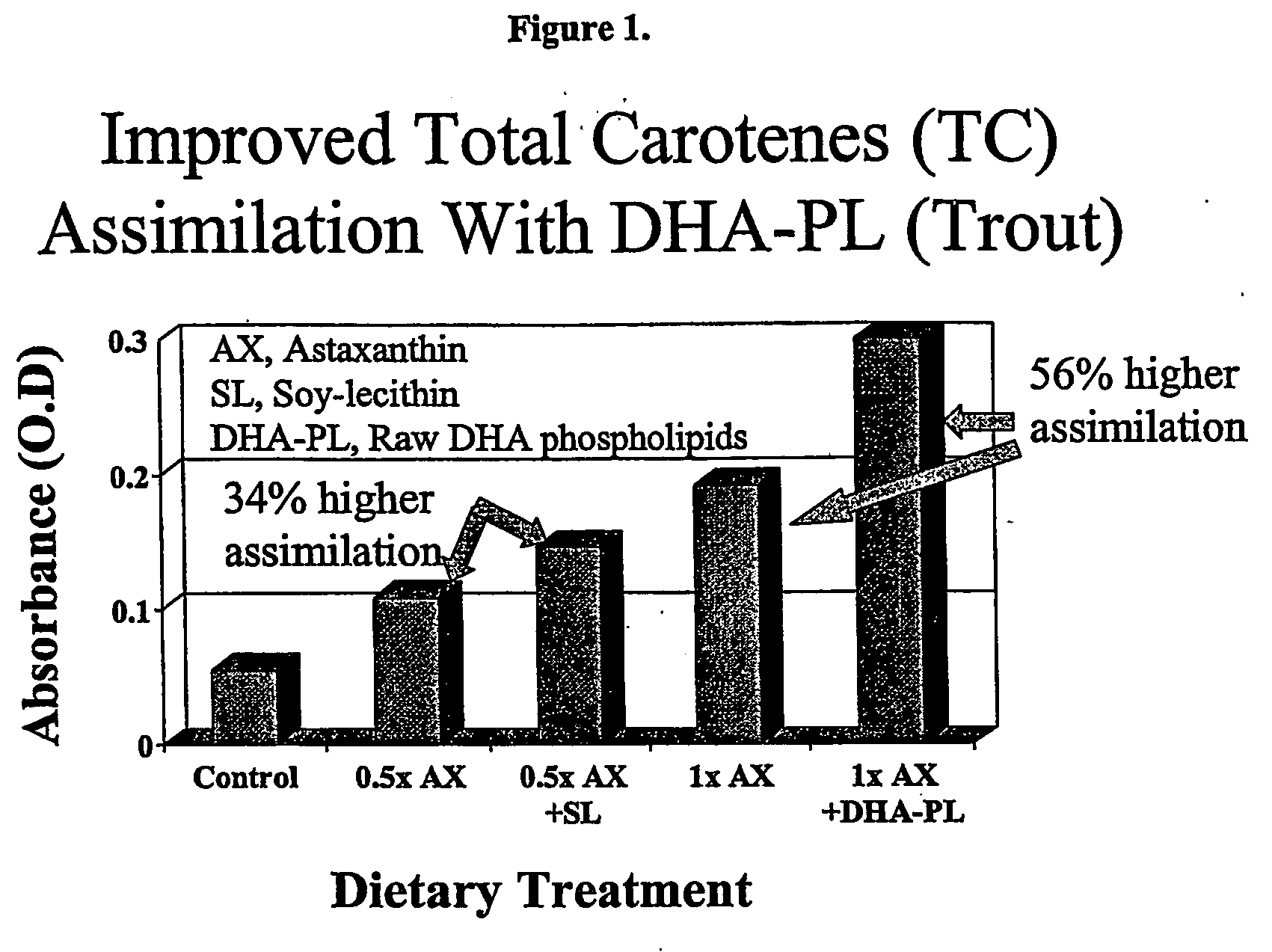Absorption of fat-soluble nutrients
a technology of fat-soluble nutrients and carotenoid compositions, applied in the field of improving the bioavailability of carotenoids, can solve the problems of inability to meet the high demands placed on xanthophyll-containing formulations with respect to coloring action and bioavailability, and the compound does not function as well in these fishes. , the effect of increasing the stability and bioavailability of carotenoid
- Summary
- Abstract
- Description
- Claims
- Application Information
AI Technical Summary
Benefits of technology
Problems solved by technology
Method used
Image
Examples
example 1
Preparation of a Composition of Synthetic Astaxanthin and Soy Lecithin
[0077] A sample of 60 g of soy lecithin (American Lecithin Co) was dissolved in ethanol, 30 g synthetic astaxanthin (AHD International, Atlanta, Ga.) was added, the mixture sonicated at 60° C. for 5 minutes, and the solvent evaporated under vacuum. The resulting powder can be incorporated with other feed ingredients or dissolved in oil and top-coated onto the feed particles.
example 2
Preparation of a Composition of Haematococcus (Containing Natural Astaxanthin) and Phospholipid Extract from Crypthecodinium Species
[0078] A sample of 50 g of algal phospholipids (Advanced BioNutrition, Columbia, Md.) and 100 g Haematococcus (Naturose, Cyanotech Corporation Kailua-Kona, Hi.) were mixed vigorously for 1 h at room temperature. The mixture was dissolved in 850 ml of Menhaden oil (Omega Protein, Houston, Tex.) and used to top-coat standard fish feed pellets. The feed pellets were top coated at a level of 20 g of the above mixture per kg feed. This produced a feed containing about 50 mg astaxanthin per kg feed. This feed was then used to color the flesh of aquatic animals that consumed the feed.
example 3
Preparation of a Composition of Phaffia rhodozyma Yeast Biomass and Phospholipid Extract from Crypthecodinium sp
[0079]Phaffia yeast was grown under standard conditions in a fermentor and biomass was harvested by centrifugation and diluted to 30% solids with water. Then 13.3 g of algal phospholipids (8 g on a dry weight basis) (ABN, Columbia, Md.) was mixed vigorously with 333 g of the Phaffia slurry (100 g on a dry weight basis) to facilitate molecular association between the carotenoid and the phospholipids. The material was then dried on a rotary drum dryer at low temperatures and the resulting flakes were milled under liquid nitrogen to produce a coarse powder. The resulting powder was then mixed with a commercial trout feed and cold pressed into feed pellets (1.2-2.0 mm, Ziegler Bros Inc. Gardners, Pa.) using standard techniques.
PUM
| Property | Measurement | Unit |
|---|---|---|
| body temperature | aaaaa | aaaaa |
| melting point | aaaaa | aaaaa |
| melting point | aaaaa | aaaaa |
Abstract
Description
Claims
Application Information
 Login to View More
Login to View More - R&D
- Intellectual Property
- Life Sciences
- Materials
- Tech Scout
- Unparalleled Data Quality
- Higher Quality Content
- 60% Fewer Hallucinations
Browse by: Latest US Patents, China's latest patents, Technical Efficacy Thesaurus, Application Domain, Technology Topic, Popular Technical Reports.
© 2025 PatSnap. All rights reserved.Legal|Privacy policy|Modern Slavery Act Transparency Statement|Sitemap|About US| Contact US: help@patsnap.com

